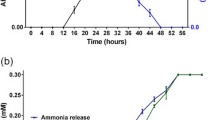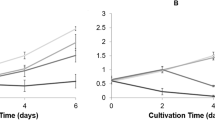Abstract
Spirulina is a photosynthetic, filamentous, spiral-shaped, multicellular, blue-green microalga. The two most important species are Spirulinamaxima and Spirulinaplatensis. Spirulina is considered an excellent food, lacking toxicity and having corrective properties against viral attacks, anemia, tumor growth and malnutrition. We have observed that cultures of Spirulina platensis grow in media containing up to 80 ppm of the organophosphorous pesticide, Chlorpyrifos. It was found to be due to an alkaline phosphatase (ALP) activity that was detected in cell free extracts of Spirulina platensis. This activity was purified from the cell free extracts using ammonium sulphate precipitation and gel filtration and shown to belong to the class of EC 3.1.3.1 ALP. The purified enzyme degrades 100 ppm Chlorpyrifos to 20 ppm in 1 h transforming it into its primary metabolite 3, 5, 6-trichloro-2-pyridinol. This is the first report of degradation of Chlorpyrifos by Spirulina platensis whose enzymic mechanism has been clearly identified. These findings have immense potential for harnessing Spirulina platensis in bioremediation of polluted ecosystems.








Similar content being viewed by others
References
Afriat L, Roodveldt C, Manco G, Tawfik DS (2006) The latent promiscuity of newly identified microbial lactonases is linked to a recently diverged phosphotriesterase. Biochemistry 45:13677–13686
Ansaruddin PA, Vijayalakshmi K (eds) (2003) The womb is not safe anymore. Indegenous Agric News 2(1):3. Available on the net at http://www.ciks.org/march-03.pdf. Cited March 2003
Baskaran S, Rai SK, Naidu R (1999) Degradation of bifentrin, chlorpyrifos and imidacloprid in soil and bedding materials at termiticidal application rates. Pest Sci 55:1222–1228
Feng Y, Racke KD, Bollag JM (1997) Isolation and characterization of a chlorinated-pyridinol-degrading bacterium. Appl Environ Microbiol 63:4096–4098
Fiske CH, Subbarow Y (1925) The determination of phosphorus and the discovery of phophocreatine and ATP. J Biol Chem 66:375–400
Jones AS, Hastings FL (1981) Soil microbe studies. In: Hastings FL, Coster JE (eds) Field and laboratory evaluations of insecticides for southern pine beetle control. USDA. Southern Forest Experiment Station, Forest Service, SE 21, pp 13–14, 35
Lowry OH, Rosebrough NJ, Farr AL, Randall RJ (1951) Protein Measurement with folin phenol reagent. J Biol Chem 193:265–275
Maniatis T, Fritsch EF, Sambrook J (1989) Molecular cloning, 2nd edn, vol 3. Cold Spring Harbor Laboratory Press, pp 18.47–18.57
Mauldin RE, Primus TM, Buettgenbach TA, Johnston JJ (2006) A simple HPLC method for the determination of Chlorpyrifos in Black oil sunflower seeds. J Liquid Chrom Related Technol 29:339–348
Munnecke DM, Hsieh DPH (1975) Development of microbial systems for the disposal of concentrated pesticide suspensions. Med Facul Landbouww Rijksuniv Gent 40:1237–1247
Racke KD (1993) Environmental fate of Chlorpyrifos. Rev Environ Contam Toxicol 131:1–151
Ronald M (1997) Atlas handbook of microbiological media, 2nd edn. In: Parks LC (ed). CRC Press, Inc., p 1271
Singh BK (2009) Organophosphorous degrading bacteria: ecology and industrial applications. Nat Rev Microbiol 7:156–164
Singh BK, Walker A (2006) Microbial degradation of organophosphorous compounds. FEMS Microbiol Rev 30:428–471
Singh BK, Walker A, Morgan JAW, Wright DJ (2004) Biodegradation of Chlorpyrifos by Enterobacter strain B-14 and its use in bioremediation of contaminated soils. Appl Environ Microbiol 70:4855–4863
Subramanian G, Sekar S, Sampoornam S (1994) Biodegradation and utilization of organophosphorus pesticide by cyanobacteria. Int Biodeterior Biodegradation 33:129–143
Yang L, Zhao YH, Zhang BX, Yang CH, Zhang X (2005) Isolation and characterization of a Chlorpyrifos and 3, 5, 6- trichloro-2-pyridinol degrading bacterium. FEMS Microbiol Lett 251:67–73
Acknowledgments
The authors wish to thank Dr.Vrinda Khole of NIRRH, Mumbai for the 2D PAGE analysis and Dr. Surekha Zingde and Dr. Rukmini Govekar of ACTREC, Mumbai and Dr. S. K. Apte of B. A. R. C., Mumbai for the MALDI-TOF experiments. Technical grade pure Chlorpyrifos was a gift from Dr. M. H. Fulekar, Professor, University department of Life Sciences, Mumbai University, Mumbai.
Author information
Authors and Affiliations
Corresponding author
Rights and permissions
About this article
Cite this article
Thengodkar, R.R.M., Sivakami, S. Degradation of Chlorpyrifos by an alkaline phosphatase from the cyanobacterium Spirulina platensis . Biodegradation 21, 637–644 (2010). https://doi.org/10.1007/s10532-010-9331-6
Received:
Accepted:
Published:
Issue Date:
DOI: https://doi.org/10.1007/s10532-010-9331-6




